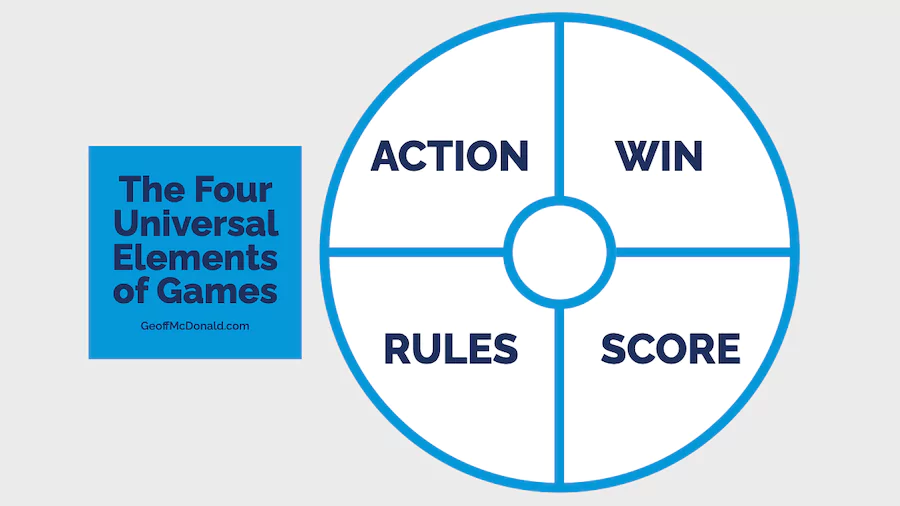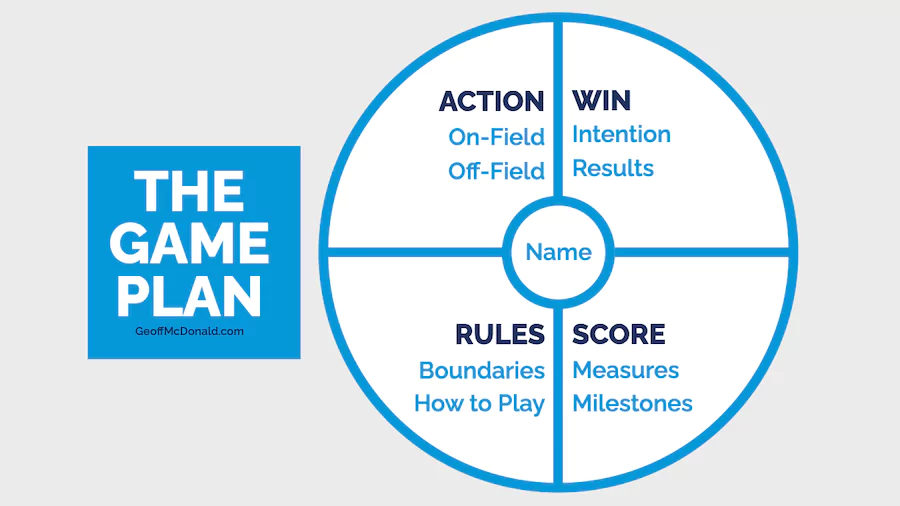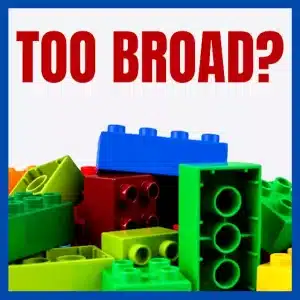The best project planning example is for those of you who want to be successful as a content creator and thought leader.
Two things Every Content Creator Needs
To consistently create great content you need to do two things.
- First, you must consistently create and share content.
- And second, you must consistently grow your skills to create better content.
To make this happen you need to create a project. Projects focus your attention on something specific that you want to learn and achieve.
While there are hundreds and thousands of examples of project plans on YouTube, very few of them are specifically for content creation.
Plus, in my view, most use project planning templates that are conservative and outdated.
The Best Project Planning Template
In my previous post, I shared the best project planning template. It was the result of over three years of research.
But surprisingly, it wasn’t a traditional project plan. Instead, it was a game design.
In that post, I shared the nine principles of the project planning template. If you haven’t already read it, go back and check it out to get the overview.
Today, I’ll show you my personal project planning example for my current content creation project. This is what I’m working on right now to make better videos.
There are nine key questions to ask.
Create Your Best Project Plan
To help create your own project planning example, download the template in the description below.
There’s a blank file as a fillable pdf and one that’s filled out with my example.
To create your best project plan, answer the key question in each section below.
1 What is your Intention?
Why are you playing your game?
Your intention is the reason you’re playing your game.
For content creators, your basic question is: Why are you creating content? Is it part of a business, your personal career or just for fun?
Then you want to drill in a bit deeper: What is the intention of this specific project? Typically, this will be either:
- To achieve a specific result eg attract 50 subscribers to your YouTube channel
- Or learn a specific skill eg I want to improve the appearance of my videos
For me, my project is part of my business. I coach people to create thought leadership quality content. And I’m publishing content on YouTube because I want to grow my audience and demonstrate how I create content.
For this project, my specific intention is to make better quality videos to engage my audience for longer. My long-term goal is to go from vlogger to movie maker.
2 What Results are you producing?
What specific and measurable results are you going to produce? And by when?
While there are lots of different ways to make better quality videos, for this project I’ve decided to focus on B-roll. If your A-Roll is me talking directly to the camera, then B-Roll is everything else like slides and video snippets. It’s often used to make transitions between scenes or sections of a video. (More What is B-Roll footage?)
My intention is to create a library of B-roll that show me at work. I want to be able to quickly and easily add them to future videos. My specific result is to create 100 pieces of B-Roll content in the next four weeks.
The two important pieces here are:
- Your result is something that you can count and measure. For example, creating better videos cannot be counted but creating 100 pieces of B-roll can.
- You need a deadline. As the old saying suggests if you don’t have a date to achieve your goal then you just have a dream.
3 What are your Measures?
How will you measure your progress?
One of the keys to staying motivated and inspired until you complete your project is to measure your progress. To achieve this, you need to translate your overall result into smaller countable units.
I’ve already set this up by the way I’ve defined my result: 100 pieces of B-Roll. Every time I create a piece of B-roll I can add it to the total.
In contrast, if you were writing a book, you don’t just want to count how many books you’ve written, because for most of your journey the score will be zero. That doesn’t help you with your motivation because it doesn’t help you see the progress you are making. Instead, you want to count the actions you will take and the results you will produce along the way. For book writing, you might count how many words you have written or how many hours you have spent writing.
For the things you will measure consider:
- What critical actions will you repeat to achieve your result? Eg spend an hour writing every day
- What results will you achieve along the way? Eg write 100 words every day
TIP: When I’ve written books, I prefer to count my time because it is more specific. I find some days I write a lot of words and other days I spend time reviewing and editing. You will need to experiment a little to find what works best for you.
4 What and when are your Milestones?
What milestones or checkpoints for your progress will you have?
One way to think about this is if your coach rang you up in the middle of your game and asked you ‘How is it going?’ How would you answer? If you don’t have a game plan in play, you’ll probably say something like, ‘Good’. But this is meaningless.
When you have measures and milestones in place, you can be more specific about your progress.
My game is to create 100 pieces of B-Roll in 4 weeks. That’s 25 per week. If I spoke to you after week one, I could say exactly how many pieces of B-Roll I’ve created, and we can compare this to the game plan. Then we can clearly say you’re ahead, behind or on par with where you wanted to be.
Can you see the connection here between your result, your measures, and your milestones? They should all be in the same currency. For me, the consistent thread is that I’m counting the number of B-Roll elements I’ve created. If you’re writing a book it might be time spent or words written.
TIP: Your milestones are a specific result by a specific time. Remember to include both.
5 What are your Boundary Rules?
How will you define the limits of your game?
In most sports there is a boundary line that says if the ball lands here it is ‘in’ and if it lands over there, it is ‘out’. We want something similar for our projects.
For instance, we want to know when the game starts and when it ends. My game is starting now and goes for four weeks. If I reach my goal before then I will say the game is won. If I don’t reach the goal, then I will stop and decide whether to continue or not.
You also want to decide what to include in your game. I’m counting video b-roll but not slides or still photos.
Your boundary rules will impact your measures and your scoring. They’ll tell you what to score and what not to score.
Some typical boundaries rules for projects include:
- The start and end of the game. Having specific dates is important here.
- What to include in the game – Define both what’s included and what’s not included as if you were teaching someone else how to run your project.
- Who will play on the game? Is it just you or will you have a team working with you?
- Where your project is being played – For instance, is it online sales or face-to-face sales. Or perhaps it’s in your local area or across the world.
6 What are your Rules of Play?
What are the acceptable actions in your game plan?
To answer this question, you might have to dig a little deeper into why you’re playing your project. For me, there are lots of great sources of B-Roll online that I could just download. But I’ve specifically said I want to create my own B-Roll. My deeper intent is to build my skills rather than just collect other people’s examples. I might still collect some of the examples of B-Roll I find online and add them to my library, but these won’t be included in my results.
And it can’t just be any B-Roll, it needs to show me working on my videos in some way.
Plus, they don’t have to be complete stories, just short ten-second video snippets.
The rules of your game might include:
- What actions are acceptable?
- What actions are not part of your game? Naturally, you don’t want to do anything illegal here.
- What is the standard or quality you are working toward? I’ve said each piece of B-Roll needs to be at least ten seconds in length.
TIP: Rather than spend time trying to define a specific standard or quality, consider using a simple rule. For example, instead of a long list of qualities (is it in focus, is the lighting good, etc) I simply have to ask myself: Am I likely to use this piece of B-Roll footage in a future video?
7 What are your On-Field Actions?
While there are always lots of actions we could take, some are more important than others.
In particular, you want to ask yourself: What are the critical actions you need to take to win your game or project? A critical action is one that you must take to win your project. Some actions are desirable, others critical.
For my game, I’ve identified four important actions.
- To save time shooting, start by writing a list of possible B-Roll to capture.
- Capture the video footage on my camera.
- Edit the results to see which ones will be worth keeping in my library.
- Put them in the library so I can access them easily in the future.
The critical action is taking the B-Roll footage. If I don’t do this, then I can’t win my game.
Also, think about the best way to get things done and bake this into your game. For instance, I don’t want to be setting up and packing up every time I want to create some B-Roll footage. Instead, if I batch my shots in groups of ten I can save time. But to do this I’ll then need to schedule my efforts in my calendar.
TIP: The best way to create a list of actions is to simply write down a big list of possible actions. Then scan through and identify the critical ones. Then scan through again to identify others that may be helpful.
8 What are your Off-Field Actions?
What other actions do you need to take to win your game or project?
You might think about this as the sort of preparation you need to take before you take your main action – as well as any action you need to take afterwards to recover. I spoke more about this here.
To work out what B-Roll to capture, I can do some research to see what other people do. This is important preparation. But I also don’t want to spend too much time on this.
While I don’t need personal recovery time (I’m not doing anything physically or mentally challenging), I could include editing out the poor shots and organising the good ones as part of the follow-up.
Plus, I need a quality standard. There is no point capturing shots if they aren’t going to be useful later. This includes a way to file them so that I can find them and use them later.
Again, brainstorm some things you could do and then select the ones that will make the biggest difference.
9 What’s an Inspiring Name for your Project?
What is a name for your project that will inspire you?
I think the best way to answer this is to go back to your intention because this taps into your motivation for playing the game.
For me, I want to go from vlogger to movie-making. Thus, I’ve chosen the project name ‘Movie Man’ to remind myself of this.
More: The Best Project Planning Example for Content Creation
That’s it. That’s my project planning example for content creation and you can see the project I am working on right now.
For more on project planning, you might like these three posts:
- The best project planning template for thought leadership
- Content Creation Process – Three Big Mistakes People Make
- IP Creation Projects for Thought Leaders
And make sure you download the project planning example and template.
Which of the nine elements do you most need to focus on in your project or game?











